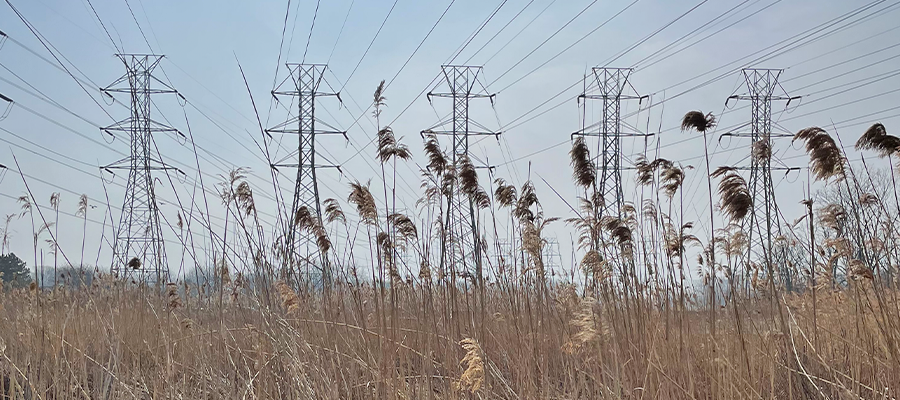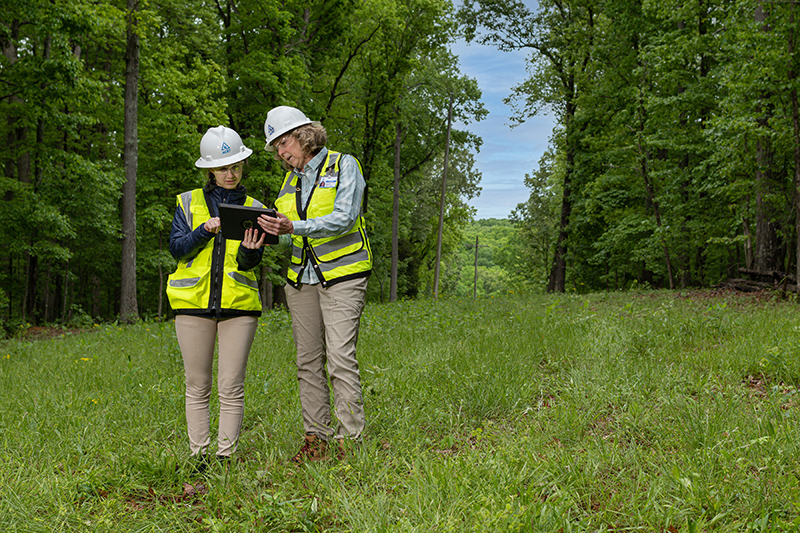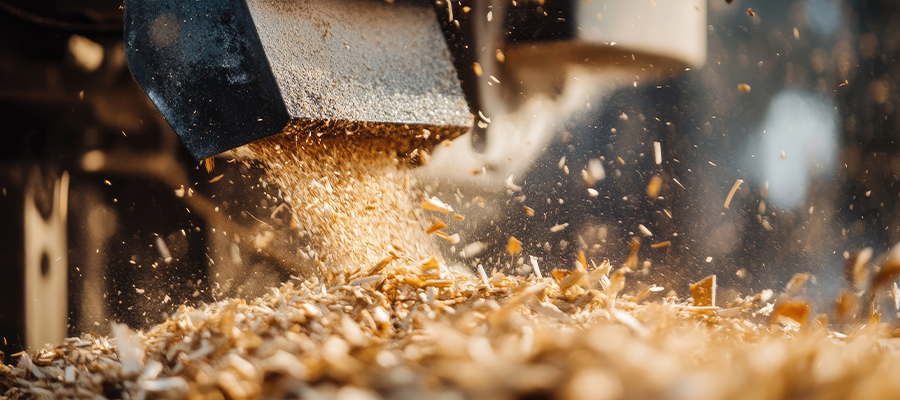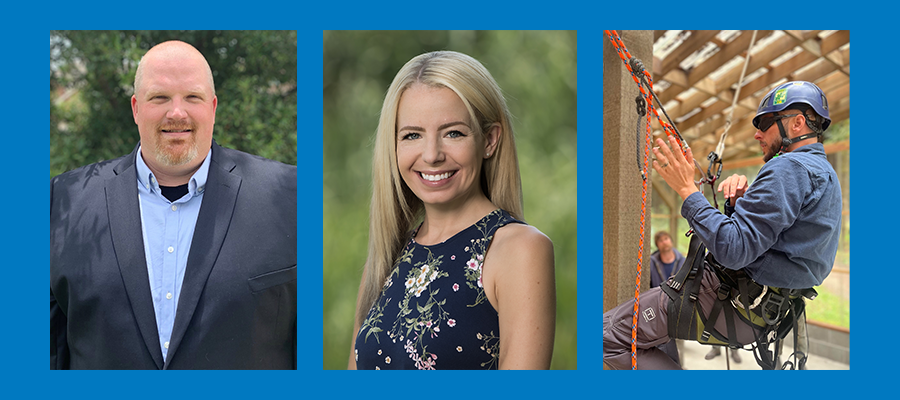- Vegetation Management Services
- Industries
- In Your Neighborhood
- About
- Careers
- Webinars
- Articles
Utility Corridors as Opportunities for Environmental Restoration

Utility Corridors as Opportunities for Environmental Restoration
By Michael Marefka, restoration ecologist and vegetation services operations manager, EnviroScience
Utility corridors, the cleared strips of land cast beneath power lines like well-manicured shadows, are a ubiquitous feature of our landscape. Transmission towers run through the outskirts of major metropolitan areas as regularly as they do through endless acres of farmland and densely forested mountain ranges. They are evidence of human interconnectivity, the reliable provision of energy to cities and towns, regardless of physical size or population. However, these corridors do not have to be limited in their function or benefit. A parallel system, the groundwork already long established, is ready for activation. Through the employment of efficient and effective restorative vegetation management, these spaces known as utility rights-of-ways (ROWs), offer a prime opportunity to establish not only human interconnectedness but ecological connectivity as well.
It may come as a surprise to utility vegetation managers and conservation land managers alike that hundreds if not thousands of acres of land in their region are poised for ecological restoration. Yet, it is a fact. ROWs are not going anywhere, and neither are the strips of land serving as their foundation. These readily accessible community investment opportunities are mutually beneficial, providing various stakeholders with an untapped resource for environmental restoration.

Regulatory Compliance Reference Guide
Ensure your program meets critical requirements with this free guide.
Environmental restoration includes the improvement of natural resources for the benefit of plant and animal life, as well as human populations by providing opportunities for education, transportation, and recreation. This article focuses on engineering systems that support plant life while balancing the regulatory considerations of ROWs. The successful establishment of vibrant, diverse plant communities can and should be seen as the first step in the process towards environmental restoration with functions flowing downstream to both animal and human benefactors.
Many utility vegetation managers might consider the introduction of native plant communities into ROWs as an unnecessary increase of risk in the system. That does not have to be the case. The very nature of utility vegetation management (UVM) is based on the suppression or complete eradication of vegetative communities to keep utilities safe and operating efficiently. However, not all vegetative communities are created equal when analyzed in the context of nuisance. Before moving on to the secondary benefits of environmental restoration, those listed above that do not directly affect the daily practice of utility vegetation managers, it is worth considering what the introduction of native vegetation will mean for practitioners. The answer lies in the control of invasive vegetation.
Invasive vegetation is hardy, aggressive, fast-growing, resilient, and overall “weedy.” Invasive woody species, those that pose the greatest threat to ROWs, are colonizing, and if left untreated quickly form dense, impenetrable thickets. Control methodologies, such as mowing, when not partnered with immediate herbicide application, can increase the density of these thickets, adding to the overall problem of control over time. Additionally, certain invasive woody species like buckthorn (Rhamnus spp.) even secrete emodin, an organic compound that prevents other plants from growing. Tree-of-heaven (Ailanthus altissima), a species that derives its name from its fast-growing nature, is one of many invasive woody species that spreads through resprouting and root suckering. Root suckering is indicative of a hardy, aggressive, and resilient species that establishes itself as a single entity within an area. These species characteristics pose major problems for utility vegetation managers as they are likely to increase the time and resources necessary for their effective control. Restorative vegetation management offers a long-term solution.
Invasive vegetation is a central problem for restorative vegetation managers, those tasked with reestablishing native habitats in areas degraded by human activity. While invasive vegetation management methodologies still and will always include the likes of mowing, burning, and herbicide application, the long-term strategy introduces an additional control mechanism: native vegetation installation. Effective vegetation control is ultimately a question of competition, and the only true competition for invasive vegetation is native vegetation. Many ROWs are most likely suffering invasive vegetation infestations from their initial construction and clearance when the disturbed ground provided the perfect opportunity for colonization. Therefore, the fight between competing plant species was never fair. Utility vegetative managers can now reintroduce competition, which will lower costs over time by establishing a more manageable and desirable habitat.
It is important to correctly adhere to the regulatory framework of managing ROWs. Violations are a primary concern. This article focuses on the introduction of native herbaceous habitat, plant species not classified as woody, to present a risk-averse strategy for the native revegetation of ROWs.
There are many considerations when evaluating ROWs for environmental restoration. Firstly, the restoration area needs to be identified. This area can encompass the entirety of the ROW or a more limited approach with overall ROW limits. Limiting factors can be environmental, such as high densities of desirable, native vegetation already on site, or managerial, such as budgetary considerations. Restoration designs are usually made with consideration for both factors. Secondly, the proposed habitat objectives need to be determined. Habitats greatly depend on the identification of upland, mesic, and wetland areas. Utility vegetation managers need to determine what will grow where and can enlist the services of wetland delineators and restoration ecologists to better inform decision-making. Lastly, state, local, and federal permits might be required based on the identified restoration area and corresponding habitats. A thorough review of permitting needs should be conducted before performing any fieldwork.
The first step for active management is developing a strategy for site preparation. Site preparation is necessary to ensure the long-term success of the restoration area. Primary considerations include the control of invasive and undesirable vegetation, and soil modification. Vegetation control usually involves the use of herbicides to eradicate target species. There are myriad herbicides available for application, most if not all of which depend on proper species and habitat identification for correct use. An herbicide application regime, which includes scheduled treatments and application methodologies, needs to be developed to effectively manage the restoration area. Following the control of target species, the soil on site may or may not need to be modified to prepare for native seeding. Soil modification can include plowing, discing, or other general forms of scarification. The purpose of soil modification is to engineer seed-to-soil contact, a critical step in successful native habitat creation. However, site conditions such as sparse existing vegetation might render soil modification unnecessary.
Though this blank slate approach might seem eerily similar to the immediate post-construction conditions of the ROW’s initial construction, the key is to install the restoration area with native seed mix, not just a combination of cover crop and turf grass seed mixes. Native seed mixes are specific to habitats and should be further informed by the overall goal of the restoration area. Mixes, just as a few examples, can be calibrated for showy wildflowers that service pollinators, dense grasslands, or low-grow erosion control. Seed can either be drilled or broadcast throughout the restoration area at varying densities of pounds per acre. Seed mixes can be purchased from accredited nurseries and calibrated to prioritize specific species. Such customization allows for project goals that can accommodate the concerns of various stakeholders.
Lastly, restoration areas will require maintenance. Although the establishment of native vegetation mitigates the presence of nuisance species, it is not a one-time solution. However, with a higher ratio of desirable to undesirable vegetation, the areas in need of costly treatment will decrease. This is an opportunity for new partnerships with local environmental stakeholders. As is the case when any new, valued natural resource is established, there are always those willing to assist in its stewardship. Again, the benefits are multiplied.
The function of ROWs and their potential to provide ecological function do not have to be treated as separate entities. In fact, combining the two functions can further establish ROWs as essential and welcoming infrastructure in a region. This multi-use approach can be employed to maintain healthy and vibrant relationships with adjacent communities, especially as it relates to alleviating concerns about disturbance to natural areas. Furthermore, the environmentally restored ROWs themselves can become destinations, nexus points for trails like Hike & Bikes, which continue to grow in popularity as a means of sustainable transportation and recreation.
Not all ROWs will be eligible for environmental restoration, and even for those that are, not all areas within the corridor might make sense for native revegetation. However, the benefits are worth the investigation.
This article was originally published in the 2025 March/April edition of the UAA Newsline.
Related Articles

Servant Leadership in Utility Vegetation Management By C. Troy Ross, President, ACRT and ACRT Pacific On a chilly Monday morning, a utility vegetation management crew gathers for their weekly briefing. Instead of launching into instructions, their supervisor begins by asking each team member how they’re doing. One mentions a child’s illness, another shares excitement about[...]
Read More
Turning Vegetation Waste into Opportunity By Aana Agrawal, Sustainability and Resilience Manager, EnviroScience The utility vegetation management (UVM) sector plays a crucial role in ensuring the smooth transmission of power across regions and cities by keeping plant growth under control within the vicinity of transmission and distribution lines. However, unrefined vegetation maintenance practices often focus[...]
Read More
Reflections from Will Nutter Silver Shield Award Recipients By Bob Urban, Senior Manager, ACRT Services In an industry where the stakes are high and every decision can have life-altering consequences, leadership in utility arboriculture isn’t just a managerial function; it’s a calling. Nowhere is this more evident than in the recipients of the Will Nutter[...]
Read More
The Electric Butterfly: Reconnecting with Nature on the Edges By Ryan Meccage, Business Development Manager, ACRT Services In an age dominated by smartphones, constant connectivity, and algorithm-driven content, we’ve never been more digitally immersed. Yet somehow, we’ve also never felt so far removed from the natural world beneath our feet. The urge to step away[...]
Read MoreRecent Posts
- Alex Fields Awarded ACRT Safety Challenge Coin 20th Nov 2025
- Servant Leadership in Utility Vegetation Management 12th Nov 2025
- ACRT Honors Our Veterans 10th Nov 2025
- Anna Davis Awarded Safety Challenge Coin 04th Nov 2025
- ACRT Senior Consulting Utility Forester Recognized as Safety Superstar 15th Oct 2025
Categories
The Leader In Vegetation Management
We are all about people, and we put safety first. Ready to work with our well-trained team?